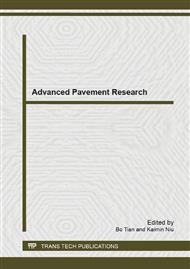p.27
p.35
p.42
p.51
p.56
p.64
p.70
p.75
p.81
Study on the Effect of Different Admixtures on the Early Autogenous Shrinkage of High Performance Concrete of Bridge Deck Pavement
Abstract:
This paper analyzed the mechanism of early autogenous shrinkage of concrete, and studied the influence of early autogenous shrinkage of high performance concrete-(HPC) admixed with different kinds of materials of bridge deck pavement. Four different concrete mixes were used: fiber, fiber plus expansive agent, fiber plus fly ash and fiber plus shrinkage-reducing agent. The result shows that the four different mixes can inhibit the autogenous shrinkage of HPC to a certain extent, the inhibitory effect of different mixes in the order of strong to weak is: fiber plus shrinkage-reducing agent, fiber plus fly ash, fiber plus expansive agent, and fiber itself. Furthermore, the inhibition mechanism of each mix was analyzed and a conclusion of mixture of fiber plus fly ash to be the best choice considered of economic and working performance is drawn as well.
Info:
Periodical:
Pages:
56-63
Citation:
Online since:
December 2013
Authors:
Price:
Сopyright:
© 2014 Trans Tech Publications Ltd. All Rights Reserved
Share:
Citation:


